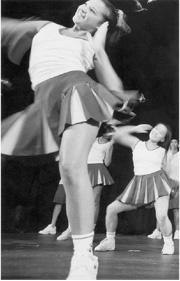EVER SINCE ITS CREATION in 1959, the Barbie doll has been the subject of much adult fascination and controversy. As detailed in Susan Stern’s surprising documentary, Barbie Nation: An Unauthorized Tour, Barbie, which was created by Mattel cofounder Ruth Handler, was the first doll in America to have a “real adult body.” In other words, she had breasts. This attribute, which allowed girls to play grown-up without messing up their mother’s closets, caused many parents (including some of the male executives at Mattel, who didn’t think the doll was appropriate for children) to titter. But that was only the beginning: As Barbie became the most popular—and most profitable—doll in the world (two Barbie dolls are sold every second), the controversy surrounding her grew. Faster than you can say anorexia nervosa, many adults began blaming the doll for reinforcing a host of social ills.
Forbidden Barbie: A collection of films about the first lady of fashion.
September 23-26 at Little Theater
Barbie Nation, which is included in a group of Barbie-themed films screening at the Little Theater, tells the story of Handler, a self-made businesswoman who revolutionized the toy industry. It also introduces us to the peculiar world of Barbie fans, a cultish set to whom the doll is much more than a nostalgic piece of their childhood. As Stern states, everyone has a Barbie story, and the stories are about ourselves.
Some people never seem to grow out of their Barbie dolls. Instead, the dolls grow up with them. There’s Caroline and Barbara, who’ve created an S&M diorama filled with leather-clad Barbies with painted-on nipples and Ken dolls with penis attachments that would impress Tom of Finland. A Barbie art show at a California gallery shows the doll morphed in various ways to resemble other icons. There’s a Barbie with Frida Kahlo-like eyebrows, there’s Barbie nailed to a cross, there’s homeless Barbie with a hand held out for change. . . .
For some, like Sandi Holder, a middle-aged Barbie dealer who sells vintage dolls, Barbie represents a kinder, safer time. “Barbie would never do drugs or have a drinking problem,” she says. But others in the film have a much darker view of the doll. A group of protesters stands in front of a toy store, telling passersby that the doll encourages women to get breast implants at the risk of their health. While it seems unfair to target a child’s toy for an adult’s decision, the protesters aren’t entirely misguided. Barbie is far from being solely responsible for women’s struggles to attain the “perfect” body, but it’s evident from Stern’s documentary that the doll plays a powerful role in shaping girls’ values and our culture’s pervasive idealization of a woman who happens to be blonde, thin, and busty.
Kerry, an art student, shows photographs of Barbie’s body parts with captions that recall her teenage experiences of modeling and dieting. No longer a waif, Kerry states that not being thin makes her feel that she has to be “better at everything else.” It’s a sad testimony to how stubbornly our minds equate thin with good. Is it any wonder that most of the people in the film seem to have a love-hate relationship with Barbie? After all, many of us have love-hate relationships with our bodies—even those of us who are blessed with Barbie-type good looks.
The images of Barbie and Ken lend tremendous power to a certain notorious first film by a now-famous director. The film, included in Little Theater’s program but which I cannot name due to legal repercussions, uses the dolls to depict the rise and fall of a ’70s musical duo whose singer died from starving herself. While Ken maintains his inanimate mask, his chalk-white smile constantly in place as he beseeches Barbie to eat, Barbie literally deteriorates before our eyes, her plastic face scraped and whittled away as her disease worsens. Made while the director was a university student, the film intersperses its campy dialogue between the dolls with academic rhetoric, defining anorexia as “the addiction to and abuse of self-control, a fascism of the body.” There’s a stream of sobering images—Nixon declaring war, emaciated prisoners in concentration camps, bombs dropping from planes—while in the background, our smooth-voiced singer coos about simple pleasures with her trademark girlish innocence.






